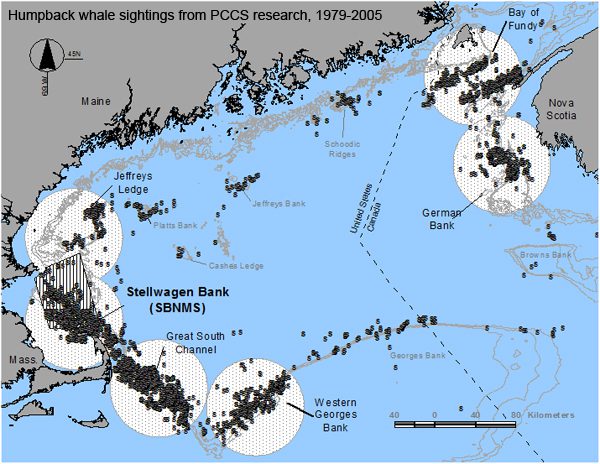Gulf of Maine population research
The Gulf of Maine, off New England, is one of several major humpback whale feeding areas in the North Atlantic Ocean. The Center studies this population across its feeding range, from the waters off Nantucket, Massachusetts to Nova Scotia, Canada. We are the only organization committed to studying individual whales across the entire Gulf of Maine population each year. Our work takes us to many near-shore and offshore areas each year, including Stellwagen Bank, the Great South Channel, Georges Bank, the Bay of Fundy and many other ridges, ledges and banks (see below). This wide spatial coverage is necessary to fully understand population size, structure and dynamics, as well to ascertain the effects of human activities.

Each year, we spend over 60 days at sea, collect over 25,000 images of at least 500 individual humpback whales. Individual humpback whales are identified based on their unique fluke pigmentation and dorsal fin shape. High quality photographs are taken to confirm the identity of whales that we have previously cataloged, and to add new individuals as they are encountered. For each individual encountered, we collect a wide range of data, including life history and behavior, samples for laboratory analysis and data for determining human impacts. All of our field work is conducted under U.S. and Canadian whale research permits.
We collaborate with other scientists and a wide range of whale watch based data collection programs in the Gulf of Maine to better understand this population (learn more here). These data contribute to our Gulf of Maine Humpback Whale Catalog and we also share photographs with the North Atlantic Humpback Whale Catalog in order to facilitate ocean scale research.
By studying unique individuals, we continually build upon data that we have collected annually since the 1970s. One important humpback whale named “Salt” has been seen in the southwest Gulf of Maine every year since the mid-1970s, and many others have similarly long sighting histories. Our longitudinal studies have provided insight into a wide range of topics, such as vital rates, habitat use, contaminant loads, and entanglement in fishing gear. This work also contributes to the development of new techniques for understanding large whales, such as the ability to age living humpback whales (see Polanowski et al. 2014) and determine their pregnancy state (see Pallin et al. 2018).
The Gulf of Maine is only one feeding area in the North Atlantic. There are others off Eastern Canada (Gulf of St. Lawrence, Newfoundland and Labrador), west Greenland, Iceland and Norway. Photo-identification research has shown that individuals maintain strong fidelity to the specific feeding area where they were brought by their mother during the first year of life. Much of what is known of population structure in the North Atlantic comes from a systematic, ocean-scale study known as the YONAH project. Learn more about YONAH here.
Learn about our primary field research techniques or the details of our research results (see scientific publications). For more general information about humpback whales, look here.


